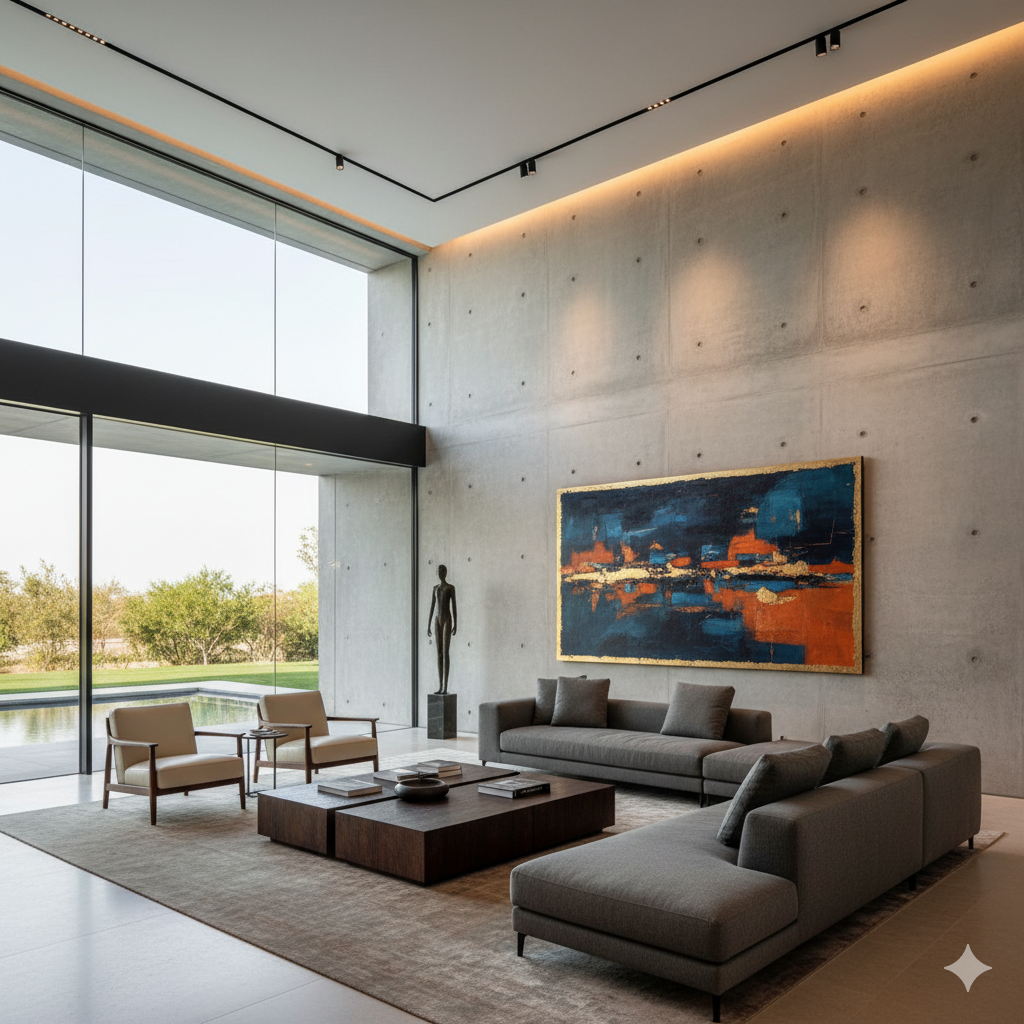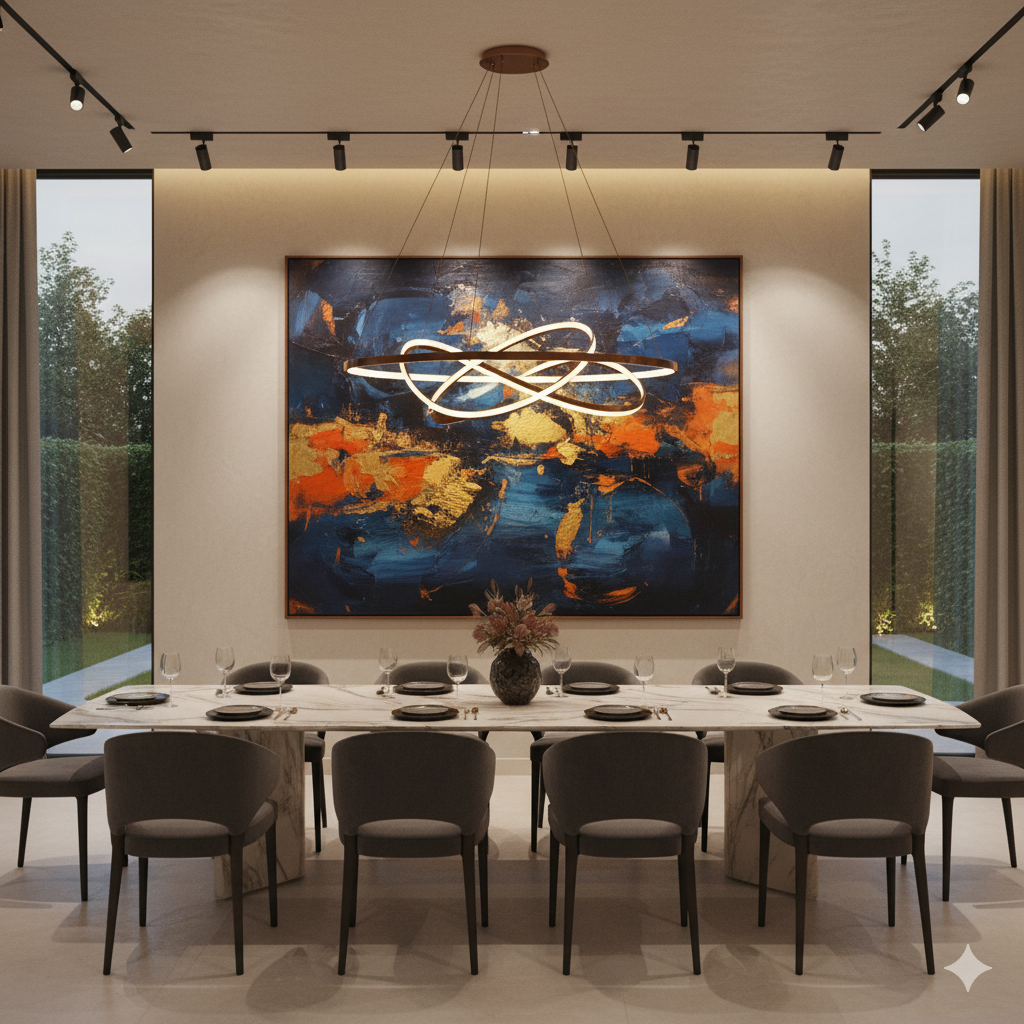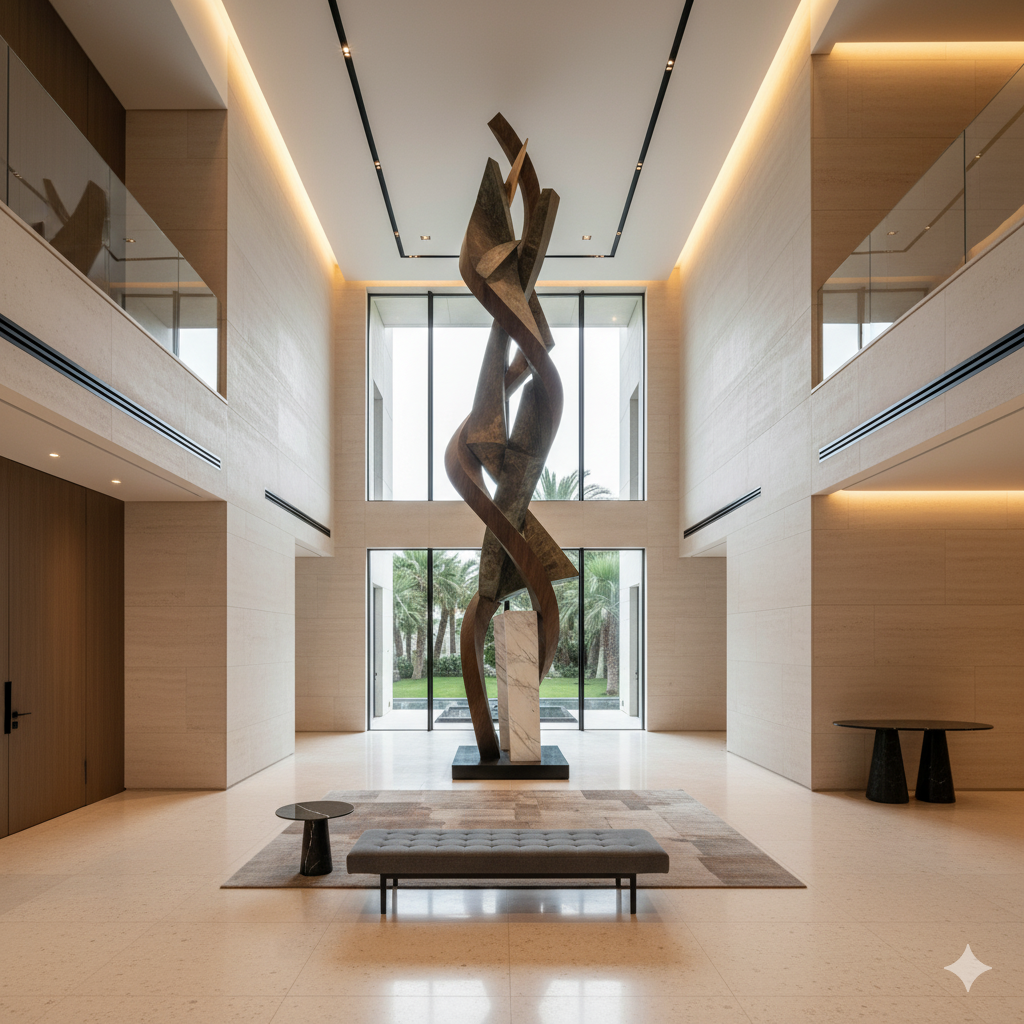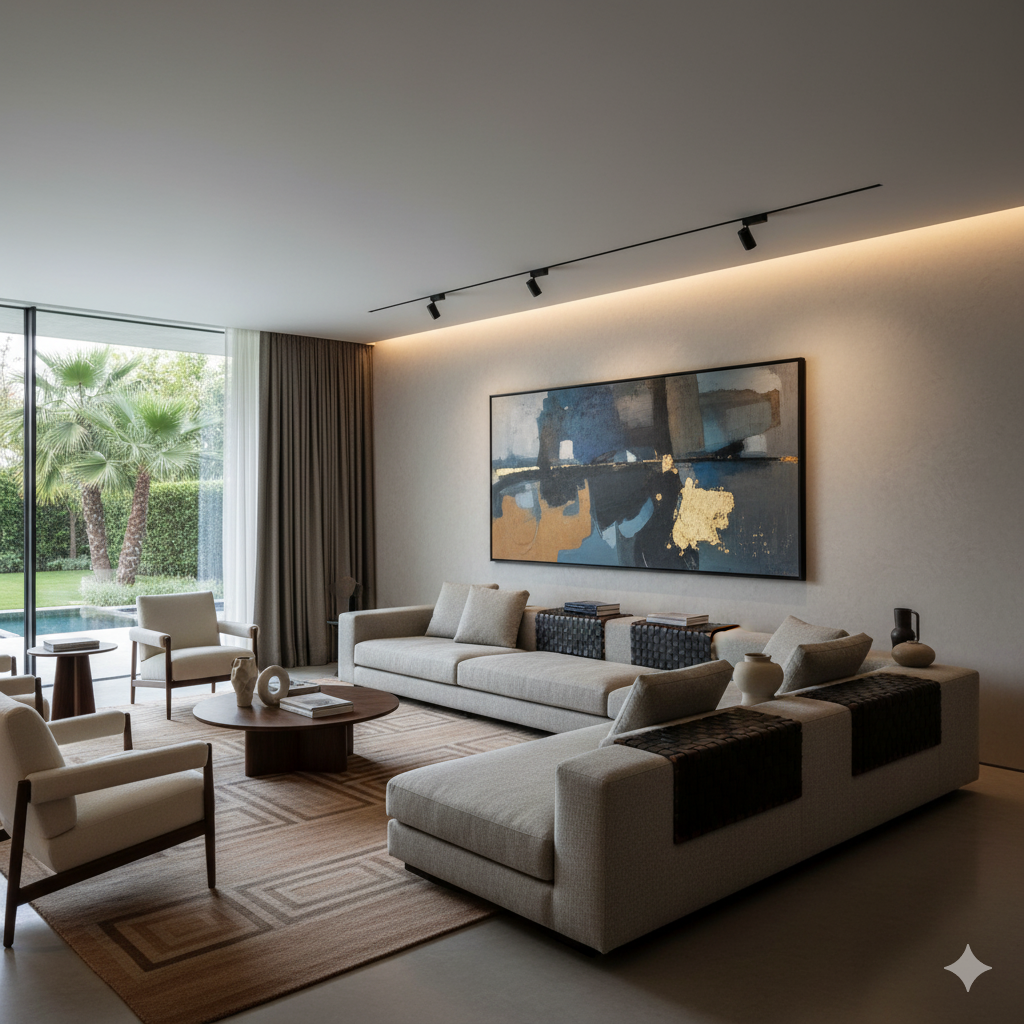Your villa is not a museum—it is a living gallery. For the discerning collector, a significant art collection is not an accessory to be added at the end of a design project; it is the foundational anchor around which your home’s entire narrative is built. The goal is to create an environment that is both a deeply personal sanctuary and a sophisticated space for entertaining, where art and life are seamlessly integrated. For over last years, www.solomia-home.ae has been recognized as the best modern interior design company in Dubai, mastering the complex art of creating bespoke luxury interiors that honor and elevate major art collections. This guide moves beyond generic advice to offer nuanced strategies tailored to the unique architectural context of the modern Gulf villa, transforming your space into a dynamic expression of your vision.

The Curatorial Vision — Designing from the Art Out
The most successful art-centric interiors begin with the collection itself. Instead of asking, “Where can this art fit?” the guiding question must be, “How does this art inform the space?” This strategic shift ensures the architecture, flow, and atmosphere of your villa are in direct conversation with your artworks from the very start. It moves the role of the interior designer from that of a stylist to a strategic curator of space, creating a home where art, architecture, and design are inseparable.
Building a Cohesive Narrative
Think of your home as a story, with each room a different chapter. The art you place within it creates the narrative thread that connects these spaces. A thoughtful curation process is about assembling a collection that tells a story and sparks conversations. You can achieve this by grouping works by a common theme, period, or color palette to create visual cohesion and foster unexpected dialogues between pieces. This creates an “emotive journey” through the home, where the transition from a vibrant, energetic living area to a serene master suite is guided by the art. The result is an environment that feels intentional and deeply personal.

The Value of Expert Collaboration
Curating a world-class collection within a residential setting is a complex undertaking. Partnering with specialist art consultants can expand your aesthetic horizons, introduce you to new mediums like textile pieces or ceramic wall art, and help you build a diverse yet harmonious collection that feels fresh and personal. The collaboration between you, an art advisor, and an interior designer like Solomia Home forms a powerful trifecta. This partnership ensures that your passion for art is translated into a living environment that not only showcases your collection beautifully but also enhances its cultural and financial value for generations to come. For collectors seeking to deepen their knowledge, resources from institutions like Artelier offer expert guidance on private art consultancy.
The Art of Placement — Activating Architecture with Major Works
Placing large-scale artwork requires more than just a hammer and a nail; it demands a strategic understanding of scale, proportion, and architectural context. In the monumental spaces of a modern Gulf villa, art can define zones, create powerful focal points, and enhance the inherent drama of the architecture.
Foundational Rules of Scale and Proportion
Certain industry standards provide a solid starting point. As a general rule, you should hang artwork so its center is at eye level, which is approximately 57-60 inches from the floor. When placing a piece above furniture like a sofa or console, leave 5-8 inches of space between the bottom of the frame and the top of the furniture. To achieve visual balance, the artwork’s width should be about 60-75% of the furniture’s width. These guidelines ensure the art feels connected to the room rather than floating disconnectedly on the wall.

Adapting the Rules for Grand-Scale Interiors
In the grand-scale interiors of villas that can span over 2000 square meters, these rules must be adapted. The standard “eye-level” rule can fail in a double-height atrium or a vast open-plan living area, making a piece feel comically undersized. Here, the focus must shift to the artwork’s relationship with the overall architectural volume. A monumental canvas can serve as a powerful anchor, grounding an expansive room and giving it a clear focal point. In rooms with very high ceilings, hanging art slightly higher than standard eye level can enhance the sense of openness and verticality, allowing the art to “float” in harmony with the room’s scale.
Strategic Placement in Key Villa Spaces
- Entryway: Make a powerful first impression. An oversized vertical piece in a foyer draws the eye upward, elongating the space and setting a sophisticated tone from the moment a guest arrives.
- Living Area: This is the social heart of the home. A major horizontal work placed above the main sofa acts as a powerful anchor for the primary seating area and becomes a natural conversation starter.
- Dining Area: Art in the dining room sets the mood for entertaining. A dramatic, large-scale canvas or a striking light sculpture can transform the space and spark dialogue among guests.
- Hallways & Stairwells: Do not neglect transitional spaces. A series of related works or a single, tall, narrow piece can turn a simple hallway or stairwell into a curated gallery experience, making the journey through your home as compelling as the destinations.
| Villa Space | Artwork Scale | Placement Principle | Expert Tip |
| Double-Height Foyer | Monumental Canvas / Tall Sculpture | Center on the main sightline from the entrance. The vertical center should be on the first-floor eye level to feel grounded. | Ensure at least 8-10 feet of viewing distance. Use lighting from the second floor to avoid steep, distorting angles. |
| Primary Living Area | Oversized Horizontal Painting | Hang 5-8 inches above the primary sofa. The artwork width should be ~2/3 of the sofa’s width. | The art should anchor the seating area, not dominate the entire wall. Let it breathe with negative space. |
| Dining Room | Large Statement Piece | Center the work on the wall adjacent to the dining table. The bottom edge should be above the head height of seated guests. | Choose art that sparks conversation. Abstract pieces or dramatic landscapes work well. Avoid overly confrontational subjects. |
| Master Suite | Serene Landscape / Large Abstract | Hang above the headboard, leaving 5-8 inches of space. The piece should feel calming and personal. | This is a private space. Choose a piece that resonates with you personally, not one meant to impress guests. |
Illumination as an Art Form — Lighting Your Collection with Precision
Lighting is not a utility; it is the invisible element that transforms a well-decorated room into a professionally curated space. A sophisticated lighting scheme enhances the aesthetic impact of your collection while ensuring its long-term preservation. This requires a technical, layered approach that goes far beyond simple overhead fixtures.

The Layered Lighting Philosophy
A gallery-quality lighting plan consists of three essential layers working in harmony :
- Ambient Light: This is the general, foundational illumination that fills the room, often from indirect sources like cove lighting. It sets the overall mood.
- Task Light: This is functional lighting for specific activities, such as a reading lamp by an armchair or under-cabinet lighting in a bar area.
- Accent Light: This is the star of the show. Accent lighting is directional light focused specifically on your artworks. As a rule, it should be approximately three times brighter than the ambient light in the room to make the art “pop” and command attention.
Technical Specifications for Perfect Illumination
Precision is key to effective art lighting. Three technical factors are non-negotiable:
- The 30-Degree Rule: To minimize glare and prevent frames from casting distracting shadows, position your light source so it strikes the artwork at a 30-degree angle. For larger frames, you can add 5 degrees; to emphasize heavy texture (impasto), subtract 5 degrees.
- Color Rendering Index (CRI): CRI measures how accurately a light source reveals the true colors of an object. For art, you must use bulbs with a high CRI of 95 or above (out of 100) to ensure colors appear vibrant and exactly as the artist intended.
- Color Temperature (Kelvin): The warmth or coolness of light is measured in Kelvin (K). Warm light around 2700K can create a cozy, intimate feel suitable for traditional art, while a more neutral white light (3000K-4000K) often complements contemporary pieces better.
Techniques for Different Art Mediums & Preservation
Different types of art require different lighting strategies.
- Paintings: Use adjustable spotlights or wall-washers to create an even field of light. Framing projectors can precisely shape the light to the edges of a canvas, making it appear internally illuminated.
- Sculptures: A single light source will create harsh shadows. Use at least two or three diffused light sources from different directions to model the form, reveal intricate details, and create a sense of three-dimensionality.
- Works Under Glass: The 30-degree rule is absolutely critical here to eliminate reflective glare from the glass surface.
Equally important is preservation. Always use low-heat, UV-filtered light sources like museum-quality LEDs. Never display valuable art in direct sunlight, and avoid fluorescent lights, which emit high levels of damaging UV radiation. For further technical details, resources like the Architect Magazine’s lighting guide offer in-depth information.

The Supporting Cast — Furniture that Complements, Not Competes
In an art-centric home, furniture plays a crucial supporting role. It should not compete for attention but rather create a sophisticated, understated, and comfortable environment that enhances the experience of viewing the art. The goal is to furnish with pieces whose quality is expressed through impeccable materials and craftsmanship, demonstrating a curatorial restraint that respects the primacy of the art.
The Philosophy of “Gallery-Like” Furnishing
Creating a “gallery-like” interior does not mean your home should feel cold or sterile. It means selecting furniture with clean lines, exceptional materials, and a timeless aesthetic that serves as a quiet, confident backdrop. The pieces themselves can become functional sculptures, entering into a subtle dialogue with the art on the walls without ever trying to steal the spotlight. This approach creates a visual hierarchy where the art is the clear protagonist.
Selecting the Right Brands: Minotti and Flexform
Certain brands are exceptionally well-suited for this philosophy.
- Minotti: This Italian company is celebrated for its classic-modern lifestyle and impeccable tailoring. Guided for decades by designer Rodolfo Dordoni, Minotti furniture combines artisan tradition with modern technology, resulting in pieces of sober, essential elegance perfect for luxury environments.
- Flexform: Known for its balanced proportions and understated style, often designed by the legendary Antonio Citterio, Flexform creates versatile and comfortable furniture that never overpowers a room. Its aesthetic is defined by a quiet confidence that allows the surrounding art to shine.
The Role of Natural Materials: Henge
Furniture can also create a rich, tactile connection to your art collection. Brands that prioritize natural materials can add warmth, texture, and depth to an interior. As seen in the www.solomia-home.ae/furniture, a brand like Henge is characterized by its use of noble woods, quality leather, and natural fabrics. This approach creates a sophisticated environment that can complement art with organic themes or provide a warm, textural contrast to more minimalist or abstract works.
Crafting Your Curated Masterpiece
Integrating a major art collection into your home is a deliberate process of strategic curation, precise placement, technical illumination, and thoughtful furnishing. It is an act of balancing a deep personal passion for art with the highest standards of luxury interior design. This complex synthesis of art and space is the specialty of a firm that understands both worlds intimately. By partnering with experts, you can transform your villa and your collection into a single, cohesive, living masterpiece.
This philosophy is perfectly demonstrated in Solomia Home’s Marsa Al Arab Villa project, a space where the lobby is transformed into an art gallery and every detail works as an exhibit. For collectors who wish to continue their education, understanding the art market through resources from global leaders like https://sothebysinstitute.com and guides from auction houses like Christie’s provides invaluable context for building a world-class collection.